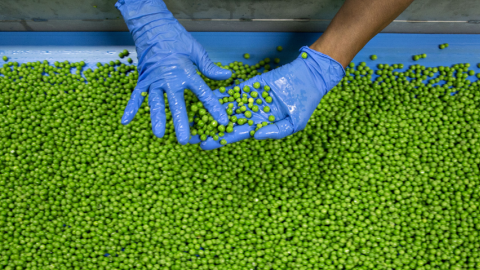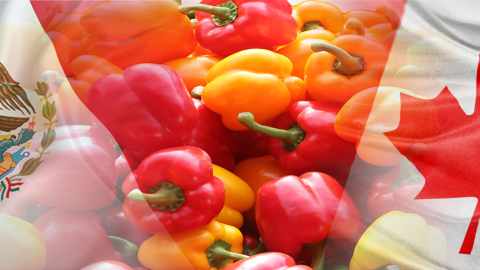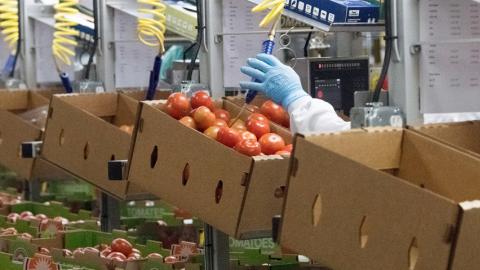The U.S. vegetables and pulses sector comprises hundreds of independent markets within the food marketing system. From 2017 to 2022, U.S. farm cash receipts from the sale of vegetables and pulses (including potatoes and mushrooms) averaged $19.9 billion—approximately 10 percent of average U.S. crop cash receipts over the same time period. This amount was generated on approximately 2 percent of all U.S. harvested acreage. Annual per capita availability (a proxy for consumption) of vegetables and pulses over the same period averaged 414 pounds—down approximately 4 percent from a decade earlier when average per capita availability was 431 pounds.
USDA, ERS provides a range of data products and reports on vegetable and pulse markets including domestic supply, demand, trade, and prices.
Periodic, Scheduled Outputs
- Outlook reports are published three times a year and provide current intelligence and forecasts on changing conditions in the U.S. vegetable and pulses sector. Interactive charts and highlights of the most recent Outlook report are available on the Market Outlook page.
- Vegetables and Pulses Data are updated monthly and provide prices, price indexes, and trade for the sector and for individual commodities.
- Vegetables and Pulses Yearbook Tables are updated annually and contain Excel spreadsheets detailing a 40 year time series of supply, availability (including per capita use), and price for a range of U.S. fresh and processing vegetables.
Recent USDA, ERS Reports Relating to Vegetables and Pulses
In addition to the periodic Outlook reports and data products, USDA, ERS disseminates reports covering issues important to vegetable and pulse crop markets in the United States and around the world. Recent USDA, ERS reports relating to vegetable and pulse crops include:
- Trends, Insights, and Future Prospects for Production in Controlled Environment Agriculture and Agrivoltaics Systems
Public and private investments in alternative food production systems have increased in recent years. Two systems, controlled environment agriculture (CEA) and agrivoltaics (AV), have been highlighted for their potential to provide socioeconomic benefits beyond food production. This study examines recent innovations in the production process for CEA and AV systems, the extent to which they have been adopted, whether these are providing output for agricultural markets, and the types of crops or other agricultural goods the systems supply. There have been growing investments in these alternative food production systems, both for commercial and research purposes. But the growth opportunities also come with economic, technical, and other challenges, which are examined in this report. - How Mexico’s Horticultural Export Sector Responded to the Food Safety Modernization Act
USDA, ERS researchers conducted interviews with Mexican horticultural growers focused on the export market to explore how their industry responded to the new requirements of the Food Safety Modernization Act (FSMA). Medium-to-large companies (300–1,000 seasonal workers) were more likely to have modified their food safety activities and to hold three or more food safety certifications—facilitating the sector’s growing presence in the U.S. market. - Specialty Crop Participation in Federal Risk Management Programs
This study characterizes recent changes in the Federal Crop Insurance Program (FCIP) and the Noninsured Crop Disaster Program (NAP). It covers program use by specialty crop farmers, compares differences among conventional and organic farms, and investigates the reasons some farmers choose whether to participate in these programs. Specialty crop growers increased the value of their crops insured by FCIP products from about $12 billion in 2011 to about $21 billion in 2020 (not adjusted for inflation). A case study of nine specialty crop growers in New York State explores reasons they choose whether to participate in these Federal programs. - Adjusting to Higher Labor Costs in Selected U.S. Fresh Fruit and Vegetable Industries
This report examines how U.S. producers of selected labor-intensive fresh fruit and vegetables address the rising costs of labor. Rising labor costs often cause producers to adjust their production and management practices to compensate for the changing cost structure. Short-term options to meet the labor needs on farms include management changes, such as picking fields and orchards less often and introducing mechanical aids that increase worker productivity. Longer-term options include the use of more labor-saving mechanization, additional H-2A guest workers, and reducing overall domestic production. - Economic Drivers of Food Loss at the Farm and Pre-Retail Sectors: A Look at the Produce Supply Chain in the United States
This study provides an overview of the drivers of food loss on the farm and other pre-retail sectors, with a focus on economic incentives that underlie the way fresh foods are grown, processed, and marketed in the United States. The study focuses on the produce sector because fruits and vegetables are highly perishable and important to diet quality. - U.S. Produce Growers' Decisionmaking Under Evolving Food Safety Standards
U.S. produce growers face increased demand for implementing more food safety practices, prompted by a series of high-profile foodborne illness outbreaks. A series of case studies with growers of five commodities in six regions reveal the industry's long history of voluntarily adopted food safety standards as well as requirements set by commercial buyers and government agencies. - Estimated Costs for Fruit and Vegetable Producers To Comply With the Food Safety Modernization Act's Produce Rule
This study estimates farm-level costs to comply with the Food Safety Modernization Act's Produce Safety Rule by commodity, State, and farm size. Across commodities and States, differences in costs are driven by differences in farm size and range from 0.3 percent of annual produce sales for the largest farms to 6.8 percent for the smallest. - Before Implementation of the Food Safety Modernization Act's Produce Rule: A Survey of U.S. Produce Growers
The "Produce Rule", which began its phased implementation in January 2018, is an on-farm Food and Drug Administration regulation that sets specific disease-preventive requirements for produce that is sold and consumed raw in the United States. The report presents results of a 2015 and 2016 survey of produce growers about their microbial food safety practices before the rule's implementation. - Food Safety Practices and Costs Under the California Leafy Greens Marketing Agreement
Using information from firms participating in the voluntary California Leafy Greens Marketing Agreement, this report provides information on the relative costs that U.S. firms could incur under similar provisions of the Produce Rule under the Food Safety Modernization Act. - Changes to the Noninsured Crop Disaster Assistance Program Under the Agricultural Act of 2014: Their Potential Risk Reduction Impacts
USDA, ERS examines impacts of the Buy-Up coverage addition to the Noninsured Crop Disaster Assistance Program (NAP) on expected payments, producers’ risk reduction, and NAP enrollment by type of producer and crops. - The Influence of Income and Prices on Global Dietary Patterns by Country, Age, and Gender
Worldwide changes in eating habits contribute to a global rise in obesity and related noncommunicable diseases (diabetes, heart disease, and stroke) across all countries, including low- and middle-income. To address this issue, this report investigates how income and prices influence dietary habits globally. - Estimating the Effects of Selected Sanitary and Phytosanitary Measures and Technical Barriers to Trade on U.S.-EU Agricultural Trade
This study investigates the effects of non-tariff measures (NTM)—specifically, sanitary and phytosanitary measures and technical barriers to trade—on agricultural trade between the United States and the European Union (EU). Along with tariff reduction, the removal of NTMs has emerged as a key focus of negotiations in the U.S.-EU Transatlantic Trade and Investment Partnership. - Agriculture in the Transatlantic Trade and Investment Partnership: Tariffs, Tariff-Rate Quotas, and Non-Tariff Measures
This study assesses the potential effects of the Transatlantic Trade and Investment Partnership between the United States and the European Union on agriculture under three broad scenarios: complete removal of tariffs and tariff-rate quotas; elimination of non-tariff measures along with tariffs and tariff-rate quotas; and a lowering of the willingness of consumers to purchase imported goods previously limited by non-tariff measures.



